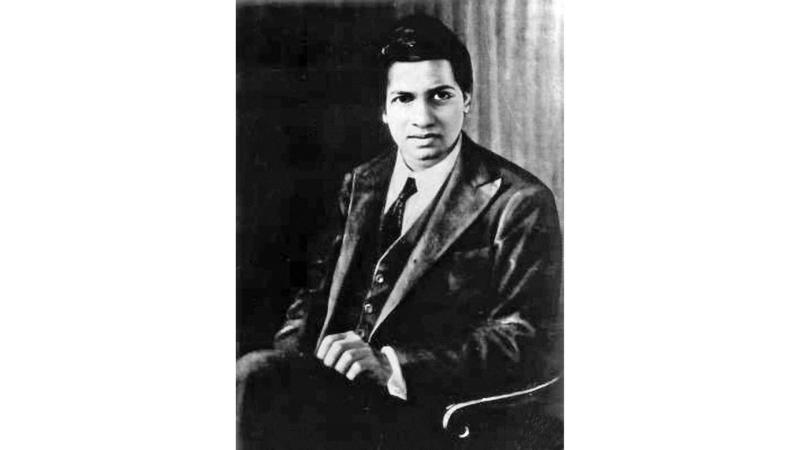
100th death anniversary of the great mathematician Srinivasa Ramanujan
Genius is when someone’s works are so profound that they not only stand the test of time but test the truths of time. It has been 100 years today since Srinivasa Ramanujan was cruelly snatched away at a young age of 32. His works are yet to be fully deciphered.
“An equation for me has no meaning unless it expresses a thought of God”, Ramanujan once said.
That this devotee of Goddess Namagiri, a goddess who he claimed wrote numbers on his tongue, reached out to an avowed atheist mathematician who eventually peeled the layers of his genius is irony of the century.
We use the term visionary loosely today but here was a man who had visions of the infinity, imbibed in him at birth and reinforced by his dreams and his deity.
Much has been written by this South Indian genius. Ken Uno of Emory University calls him a Poet. Pages and pages of notations sing and dance to those who can read his mathematical music. Most humans with celebrated talent start with a problem to solve and work with proof towards the pinnacle of an answer. The genius of Ramanujan was that he had the answers not only for the now but the next as well. Many of his notes and notations point to potential solutions for which there are no questions yet.
Labels of genius stick to someone like Einstein but what do you call someone who wrote about entire fields of mathematical theory that were invented much after he passed away. I say invented because one has to work from an answer to see why that answer is relevant to us mere mortals.
Does all this beg the question as to how do we find and nurture the Ramanujan’s of the world? Is it nature or nurture that produces such path-breaking talent? Ramanujan would not even have been a footnote in the annals of mathematics if not for Hardy. So what makes diamonds out of coal? Is such talent a rare mutation, a once in a thousand-year marvel that cannot be produced in the labs of our local universities? Something alien?
“Ramanujan’s math was almost from outer space”, says Dr. Manjul Bhargava, a fields medal winner the equivalent of a Nobel laureate in Math. Manjul learned the Tabla at a young age and talks about the source of music as a motivation for math. He ascribes the choices of notes in music to the choice of frequencies that sound good. “…two notes sound good together (i.e., are resonant) if the ratio of their frequencies is a simple whole-number ratio, like 2:1 (which is the distance of one saptak, from sa to sa) or 3:2 (which is the distance from sa to pa)”, says Bhargava.
The science of music and mathematics had long been documented in Hindu culture. India or Bharat is the land of Bharatha munivar. His Natya Sastra contains an elaborate set of rules and discusses among other things the harmonic scale, a unit known as Śruti. The melodies, transformed by Bhakti or devotion, manifested in the art form of Carnatic music and is to this day celebrated and revered all over south India.
It is in this tradition that Ramanujan was born into. He was surrounded by the songs of devotion in the temple town of Kumbakonam. He was a scholar and well versed in Vedic thought. He was known to keep his agraharam audiences spellbound with his commentary on the Shastras, bridging God and Math, Zero and Infinity.
Could it be that these vibrations of prose and poetry stoked a latent mind to conjure miracles in math?
Robert Kanigel in his epic biography on Ramanujan - “The man who knew infinity”, talks about a sullen, sick Ramanujan, a few months before his death, in a letter to Hardy.
“ I am extremely sorry for not writing you a single letter up to now”.
He goes on to say “….discovered some very interesting functions which I call “Mock” theta functions…”
Mathematicians 80 years later would go on to apply them to our understanding about Black Holes and much is still an open book.
Ramanujan’s final years of sickness made him testy to the point of erupting in anger at people around him. But he produced his best work as he suffered through his illness. Finally, on April 26, 1920, he slipped into unconsciousness and passed away soon after.
The very same shastras, followed to the rule by his agraharam neighbors that Ramanujan grew up with, kept his brahmin orthodox relatives away. He had crossed the ocean and that had caused his Brahmin status to elapse.
A mathematical athlete, a sprinter whose strides were cruelly cut short before the glory of a gold medal, Ramanujan was almost forgotten. 56 years into the date of his death a young student made a trip to France from Wisconsin. With spare time to visit Cambridge, he dug into papers left behind by G.N Watson. He hit gold with 140 pages of what would eventually be called the “The Lost Notebook”.
Progress in civilized societies does not appear to be linear. Less change is brought about by cultivated curriculum than by leaps of the untrained mind. The world should celebrate the native genius. Raw talent untainted by formal education should have the opportunity to blossom without the trappings of topics not essential to the core of that genius. Of what use are dates and History, the periodic table, or even particle physics to the mind that only sees numbers and patterns? A system that only recognizes nurtured talent, one that systematically climbs the ladder of elitist institutions is bound to inhibit leaps in true progress. The progress that India and the world desperately needs.
We need more Poets and fewer Quants to compose a better future.
Editor's note - This article has originally been published here. Republished here with the permission from the author.





